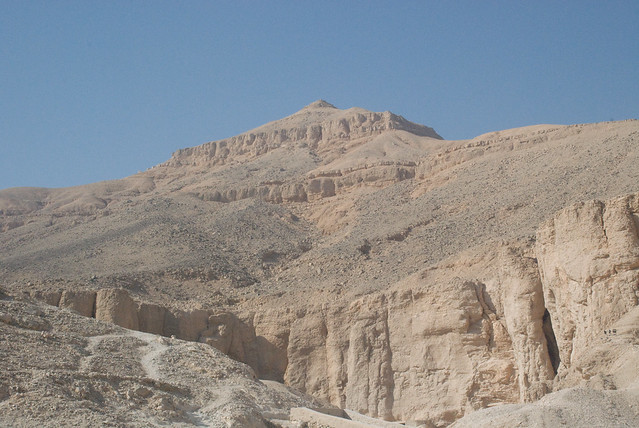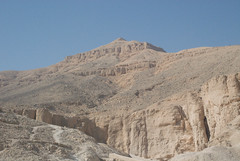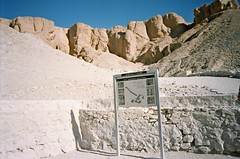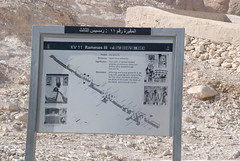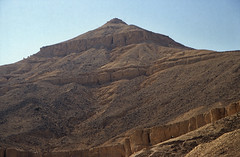Valley of the Kings
The Valley of the Kings (Arabic: وادي الملوك ; Late Coptic:), also known as the Valley of the Gates of the Kings (Arabic: وادي أبواب الملوك), is a valley in Egypt where, for a period of nearly 500 years from the 16th to 11th century BC, rock-cut tombs were excavated for the pharaohs and powerful nobles of the New Kingdom (the Eighteenth to the Twentieth Dynasties of Ancient Egypt).
The valley stands on the west bank of the Nile opposite Thebes (modern Luxor), within the heart of the Theban Necropolis. The wadi consists of two valleys: the East Valley (where the majority of the royal tombs are situated) and the West Valley (Valley of the Monkeys).
With the 2005 discovery of a new chamber and the 2008 discovery of two further tomb entrances, the valley is known to contain 63 tombs and chambers (ranging in size from KV54, a simple pit, to KV5, a complex tomb with over 120 chambers). It was the principal burial place of the major royal figures of the Egyptian New Kingdom, as well as a number of privileged nobles. The royal tombs are decorated with scenes from Egyptian mythology and give clues as to the beliefs and funerary practices of the period. Almost all of the tombs seem to have been opened and robbed in antiquity, but they still give an idea of the opulence and power of the pharaohs.
This area has been a focus of archaeological and Egyptological exploration since the end of the eighteenth century, and its tombs and burials continue to stimulate research and interest. Since the 1920s, the valley has been famous for the discovery of the tomb of Tutankhamun, and is one of the most famous archaeological sites in the world. In 1979, it became a World Heritage Site, along with the rest of the Theban Necropolis. Exploration, excavation and conservation continues in the valley, and a new tourist centre has recently been opened.
Geology
The Valley of the Kings is situated over 1,000 feet of limestone and other sedimentary rock, which form the cliffs in the valley and the nearby Deir el-Bahari, interspersed with soft layers of marl. The sedimentary rock was originally deposited between 35 and 56 million years ago during a time when the Mediterranean Sea sometimes extended as far south as Aswan. During the Pleistocene the valley was carved out of the plateau by steady rains. There is now little year-round rain in this part of Egypt, but there are occasional flash floods. These floods dump tons of debris into the open tombs.
The quality of the rock in the Valley is inconsistent, ranging from finely grained to coarse stone, the latter with the potential to be structurally unsound. The occasional layer of shale also caused construction (and in modern times, conservation) difficulties, as this rock expands in the presence of water, forcing apart the stone surrounding it. It is thought that some tombs were altered in shape and size depending on the types of rock the builders encountered. Builders took advantage of available geological features when constructing the tombs. Some tombs were quarried out of existing limestone clefts, others behind slopes of scree, and some were at the edge of rock spurs created by ancient flood channels.
The problems of tomb construction can be seen with the tombs of Ramesses III and his father Setnakhte. Setnakhte started to excavate KV11 but unintentionally broke into the tomb of Amenmesse, so construction was abandoned and he instead usurped the tomb of Twosret, KV14. When looking for a tomb, Ramesses III extended the partly excavated tomb started by his father. The tomb of Ramesses II returned to an early style, with a bent axis, probably due to the quality of the rock being excavated (following the Esna shale).
Between 1998 and 2002, the Amarna Royal Tombs Project investigated the valley floor using ground-penetrating radar and found that, below the modern surface, the Valley's cliffs descend beneath the scree in a series of abrupt, natural "shelves", arranged one below the other, descending several metres to the bedrock in the valley floor.
Hydrology
The area of the Theban hills is subject to infrequent, violent thunderstorms causing flash floods in the valley. Recent studies have shown that there are at least seven active flood stream beds leading down into the central area of the valley. This central area appears to have been flooded at the end of the Eighteenth Dynasty, with several tombs buried under metres of debris. The tombs KV55, KV62, and KV63 are dug into the actual wadi bedrock rather than the debris, showing that the level of the valley was five meters below its present level. After this event, later dynasties levelled the floor of the valley, making the floods deposit their load further down the valley, and the buried tombs were forgotten and only discovered in the early 20th century. This was the area that was the subject of the Amarna Royal Tombs Project ground-scanning radar investigation, which showed several anomalies, one of which was proved to be KV63.
History
The Theban Hills are dominated by the peak of al-Qurn, known to the Ancient Egyptians as , or "The Peak". It has a pyramid-shaped appearance, and it is probable that this echoed the pyramids of the Old Kingdom, more than a thousand years prior to the first royal burials carved here. Its isolated position also resulted in reduced access, and special tomb police (the Medjay) were able to guard the necropolis.
While the iconic pyramid complex of the Giza Plateau have come to symbolize ancient Egypt, the majority of tombs were cut into rock. Most pyramids and mastabas contain sections which are cut into ground level, and there are full rock-cut tombs in Egypt that date back to the Old Kingdom.
After the defeat of the Hyksos and the reunification of Egypt under Ahmose I, the Theban rulers began to construct elaborate tombs that reflected their newfound power. The tombs of Ahmose I and his son Amenhotep I (their exact location remains unknown) were probably in the Seventeenth Dynasty necropolis of Dra' Abu el-Naga'. The first royal tombs in the Valley of the Kings were those of Amenhotep I (although this identification is also disputed), and Thutmose I, whose advisor, Ineni, notes in his tomb that he advised the king to place his tomb in the desolate valley (the identity of this actual tomb is unclear, but it is probably KV20 or KV38).
The Valley was used for primary burials from approximately 1539 BC to 1075 BC. It contains at least 63 tombs, beginning with Thutmose I (or possibly earlier, during the reign of Amenhotep I) and ending with Ramesses X or XI, although non-royal burials continued in usurped tombs.
Despite its name, the Valley of the Kings also contains the tombs of favorite nobles as well as the wives and children of both nobles and pharaohs. Therefore, only about twenty of the tombs actually contain the remains of kings. The remains of nobles and of the royal family, together with unmarked pits and embalming caches, make up the rest. Around the time of Ramesses I (ca. 1301 BC) construction commenced in the separate Valley of the Queens.
Royal Necropolis
The official name for the site in ancient times was The Great and Majestic Necropolis of the Millions of Years of the Pharaoh, Life, Strength, Health in The West of Thebes (see below for the hieroglyphic spelling), or Ta-sekhet-ma'at (the Great Field).
At the start of the Eighteenth Dynasty, only kings were buried within the valley in large tombs. When a non-royal person was buried, it was in a small rock cut chamber, close to the tomb of their master. Amenhotep III's tomb was constructed in the Western Valley, and while his son Akhenaten moved his tomb's construction to Amarna, it is thought that the unfinished WV25 may have originally been intended for him. With the return to religious orthodoxy at the end of the Eighteenth Dynasty, Tutankhamun, Ay, and Horemheb returned to the royal necropolis.
The Nineteenth and Twentieth Dynasties saw an increase in the number of burials (both here and in the Valley of the Queens), with Ramesses II and later Ramesses III each constructing a massive tomb used for the burial of their sons (KV5 and KV3 respectively). There are some kings that are not buried within the valley or whose tomb has not been located: Thutmose II may have been buried in Dra' Abu el-Naga' (although his mummy was in the Deir el-Bahari tomb cache), Smenkhkare's burial has never been located, and Ramesses VIII seems to have been buried elsewhere.
In the Pyramid Age, the pyramid tomb of a king was associated with a mortuary temple located close to the pyramid. Since the tombs of the kings in the Valley of the Kings were hidden, the kings' mortuary temples were located away from their burial sites, closer to the cultivation facing Thebes. These mortuary temples became places visited during the various festivals held in the Theban necropolis. Most notable is the Beautiful festival of the valley, where the sacred barques of Amun-Re, his consort, Mut, and son, Khonsu, left the temple at Karnak in order to visit the funerary temples of deceased kings on the West Bank and their shrines in the Theban Necropolis.
The tombs were constructed and decorated by the workers of the village of Deir el-Medina, located in a small wadi between this valley and the Valley of the Queens, facing Thebes. The workers journeyed to the tombs through various routes over the Theban hills. The daily lives of these workers are quite well known due to their being recorded in tombs and official documents. Amongst the events documented is perhaps the first recorded workers' strike, detailed in the Turin Strike Papyrus.
Exploration of the valley
The valley has been a major focus of modern Egyptological exploration for the last two centuries. Prior to this time, it was a site for tourism in antiquity (especially during Roman times). The area illustrates the changes in the s…
Looking for places related to Valley of the Kings?
Those are other destinations to find places related to Valley of the Kings:
- Valley of the Kings
- Philae
- Hatshepsut
- Elephantine
- Colossi of Memnon
- Temple of Edfu
- TT52
- Abydos, Egypt
- Deir el-Bahari
- Deir el-Medina
- Ramesseum
- Kitchener's Island
- Unfinished obelisk
- New Kalabsha
- Thebes, Egypt
- Luxor International…
- KV62
- Aswan Low Dam
- Hurghada Internatio…
- Agilkia Island
- Mons Claudianus
- El-Tod
- Assiut Barrage
- Malkata
